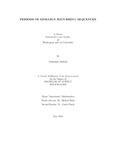| dc.rights.license | In Copyright | en_US |
| dc.creator | Quijada, Danjoseph Keeny B. (DJ) | |
| dc.date.accessioned | 2015-07-29T19:59:08Z | |
| dc.date.available | 2015-07-29T19:59:08Z | |
| dc.date.created | 2015 | |
| dc.identifier | WLURG38_Quijada_MATH_2015 | |
| dc.identifier.uri | http://hdl.handle.net/11021/32172 | |
| dc.description | Thesis; [FULL-TEXT FREELY AVAILABLE ONLINE] | en_US |
| dc.description | Danjoseph Keeny B. (DJ) Quijada is a member of the Class of 2015 of Washington and Lee University. | en_US |
| dc.description.abstract | In this thesis, we investigate sequences defined by linear recurrence relations. These are sequences whose subsequent terms are generated using some linear combination of the previous terms. We call the equation that determines the next terms of the sequence the "linear recurrence relation" satisfied by the sequence.
As it turns out, if the ring over which the sequence is defined is finite, then the sequence is guaranteed to eventually repeat. It is then natural to consider the following questions: (1) What factors determine the periods of these sequences once they begin to repeat? And (2) which periods arise from sequences that satisfy a particular linear recurrence relation, or from linear recurrences over a particular ring? Here we address these kinds of questions. Predicting the periodic behavior of any particular linearly recurring sequence, however, is actually exceedingly difficult, and so we instead attempt to determine the sets of periods that will arise from sequences defined by linear recurrences of a fixed degree and over some well-behaved ring.
In Chapter 2, we discuss various properties of sequences defined over a finite (commutative) ring with unity. In particular, we generalize a result of Ward to show that the set of sequences has a natural ring structure and decomposes into a direct sum of periodic and null sequences (see Proposition 2.30). In Chapter 3, we give an exposition of the theory of sequences defined over finite fields. In particular, we show that the (least) period of a sequence is the order of a certain polynomial (see Theorem 3.17). We use this to describe the sets of possible periods of all linear recurrences of given degree k for small k. Finally, in Chapter 4, we apply some of the earlier theory to understand the periods of sequences defined over finite quotients of principal ideal domains. | en_US |
| dc.description.statementofresponsibility | Danjoseph Quijada | |
| dc.format.extent | 67 pages | en_US |
| dc.language.iso | en_US | en_US |
| dc.rights | This material is made available for use in research, teaching, and private study, pursuant to U.S. Copyright law. The user assumes full responsibility for any use of the materials, including but not limited to, infringement of copyright and publication rights of reproduced materials. Any materials used should be fully credited with the source. | en_US |
| dc.rights.uri | http://rightsstatements.org/vocab/InC/1.0/ | en_US |
| dc.subject.other | Washington and Lee University -- Honors in Mathematics | en_US |
| dc.title | Periods of Linearly Recurring Sequences (thesis) | en_US |
| dc.type | Text | en_US |
| dcterms.isPartOf | RG38 - Student Papers | |
| dc.rights.holder | Quijada, Danjoseph Keeny B. (DJ) | |
| dc.subject.fast | Sequences (Mathematics) | en_US |
| dc.subject.fast | Finite fields (Algebra) | en_US |
| local.department | Mathematics | en_US |
| local.scholarshiptype | Honors Thesis | en_US |
